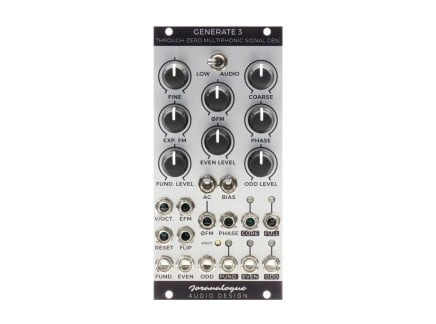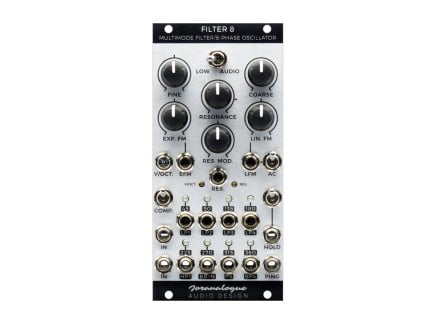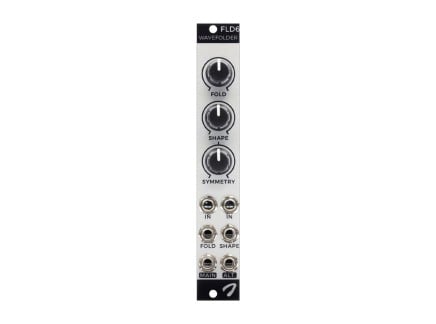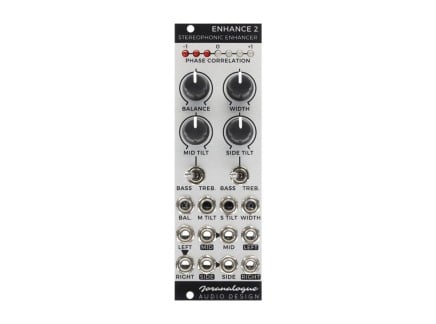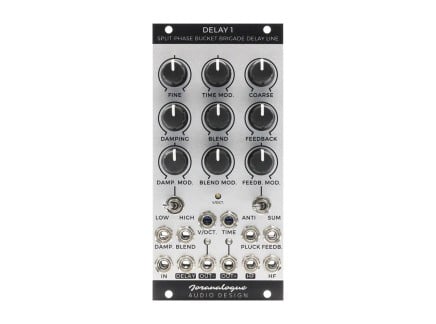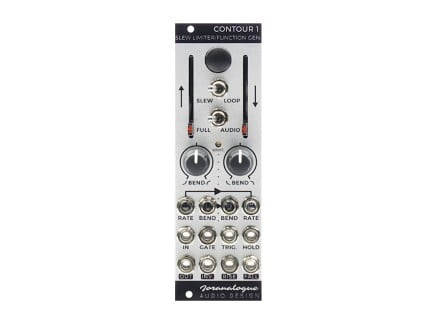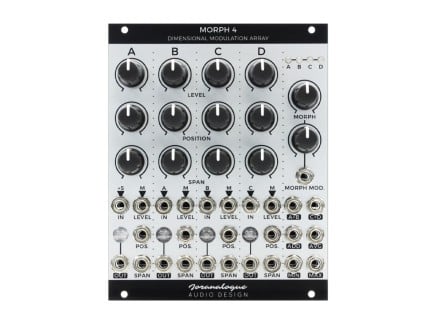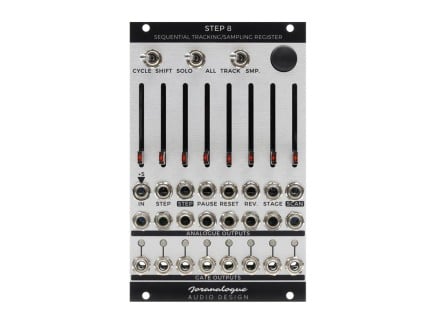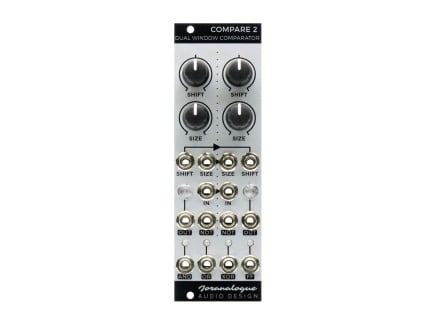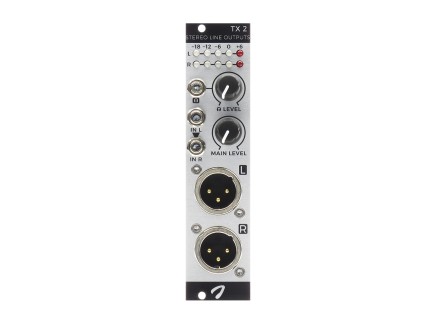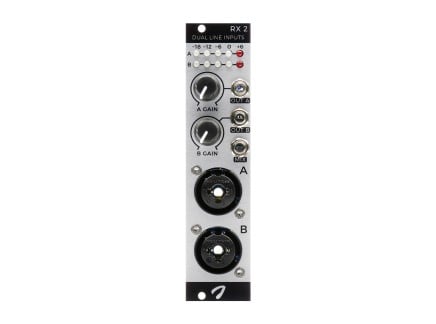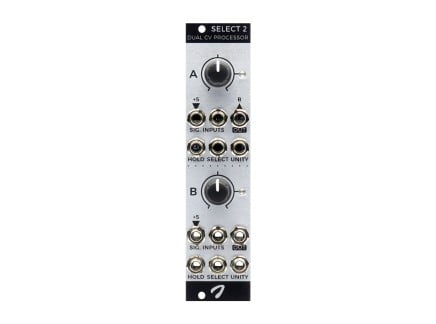For some, the appeal of Eurorack modular synthesizers has to do with the huge amount of variety available in the format. Because the "rules" of the format are standardized, it means that there are hundreds of manufacturers who all make compatible devices. So, when building a Eurorack system, it's possible to create an instrument that combines ideas from many different creators into something that uniquely suits you. For some, that can be a tremendous inspiration.
However, it's not the only way to approach things. As time has gone on, more and more Eurorack manufacturers have taken it upon themselves to create their own self-sufficient synthesis ecosystems. This has long been the case for companies like Doepfer, Intellijel, and Make Noise, for instance, but in the past several years, several others have come into the fold, gradually building up a catalog of modules that can act as its own complete instrument. This has significant advantages: when an instrument is designed by a single person or team, it may gain greater conceptual unity.
Of all companies to reach this status in recent years, we firmly believe that Joranalogue is one of the most interesting. For the first couple of years of their public existence, they mostly produced utility modules—switches, voltage meters, etc.—finding their way into many systems through the sheer usefulness of their designs. However, piece by piece, they've begun producing much more complex designs; and now, their catalog contains everything from chaotic oscillators and complex filters all the way to mid/side processing and patch-programmable modulation sources. And of course, they're still producing the ever-so-useful utility-style modules that they've built from the start.

In some ways, the prominence of these utilities coupled with the conceptual complexity of their more intricate designs says a lot about their conceptual approach as instrument makers. The combination of utilitarian building blocks and highly flexible modules suggests a somewhat Serge-like approach: analog designs that allow you to get a ton of mileage out of a single module simply by changing the way it is patched. This means that, even with a small system, you can achieve a ton of sonic variety—and it means that, in many cases, a module can do much more than what may initially seem possible.
In this article, we're going to talk through Joranalogue's current lineup. We'll take a look at their sound sources, sound processors, modulation sources, and utility modules...but you'll quickly see that many of these modules can serge multiple roles outside the obvious. Luckily, Boris from Joranalogue recently came to our shop to walk us through some patching ideas—so be sure to check out the video above to get a sense of how a patch might evolve on a Joranalogue system. If you're curious to learn more, keep on reading.
Joranalogue's Sound Sources
While you might normally expect an oscillator to be among the first products by a Eurorack company, Generate 3 came along after Joranalogue had already developed a modest catalog of modules. But we're almost certain that this module was cooking behind the scenes for a long time, because like each of Joranalogue's other designs, there's a lot packed into Generate 3. Sure, it's essentially just an oscillator with low-frequency and audio-rate modes, but it's the additional features that make Generate 3 a remarkable signal generator for the explorative patcher.
Generate 3 begins with a highly-precise triangle-core oscillator that supports through-zero frequency modulation. Thru-zero FM, as implied by the name, allows the oscillator's frequency to travel past 0hz and effectively reverse direction. With manual or slow adjustments this has no real sonic difference, but with audio-rate modulation, a clearer and more accurate perception of pitch is maintained thanks to the ability to move in two directions than just one. This flavor of FM has become quite a trend in Eurorack since this module's release, but Generate 3 goes the extra mile by offering thru-zero phase modulation: a similar sound to FM commonly employed by digital synthesizers like the Yamaha DX7.
The other way that Generate 3 is unique is in its flexibility to produce many variable waveforms at each of its outputs and create blends between them. While the Core output is the raw triangle wave unaffected by the phase modulation circuit, you can find sine, saw, and a unique spiked waveform at the Fundamental, Even, and Odd outputs, representing their respective harmonic content. In addition to a Full output which presents the sum of all three waveforms, each also has its own level control and control voltage supporting through-zero amplitude modulation, otherwise known as ring modulation. As such, Generate 3 is clearly an oscillator for the synthesist with a deep desire to shape their oscillator tones to their exacting demands. But...that's not their only oscillator.
The concept behind the Joranalogue Orbit 3 is Chaos Theory, a mathematical concept that reveals deterministic outcomes in seemingly random patterns. Specifically for this module, Joranalogue uses a Lorenz attractor—or double-scroll attractor—which is a model originally observed in meteorological patterns and, when plotted or simulated, creates a shape similar to a figure-8 or butterfly. When this shape is used for musical purposes, unique and familiar waveforms are easily accessible, creating a wonderful sonic palette that can range from a sine, square, any color noise, noisy versions of any waveform. Additionally, the module can be used as a chaotic modulator in LFO mode.
Imagine a 3D space that has plot points along the positive and negative X, Y, and Z axes. Inside of this space is a particle that is orbiting around two points floating along the various axes—and that is what each of the six chaos outputs are based on. In the audio realm, this translates to changes in amplitude along the waveform, and when combining multiple outputs, especially if you use a stereo mixer, the combinations are incredibly satisfying. Self-patching is encouraged, yielding great results for even more sonic options.
Switching into LFO mode reveals a whole new dimension of modulation possibilities, as you now have six phases of the particle to create derivative motion that feels organic. A seventh Equilibrium Point output can act as a pseudo-random gate output in LFO mode, representing the points of rotation for the particle with 0V for the negative and +5v for the positive. Using the controls will yield high interactive results and overall this is an interesting module that, happily, doesn't require an advanced degree in mathematics to understand. The layout and intuitive nature of the module makes this useful in any context.
Joranalogue's Audio Processors
Of course, there's more to Joranalogue than snazzy audio sources. Let's take a look at some of their audio processors—pointing out along the way how they can all deviate from their obvious uses.
Although they're among the most ubiquitous synthesizer modules, filters tend to be a somewhat complex circuit. They usually involve several cascaded filtering stages, but as a result, this allows for some interesting features, should the designer feel inclined to venture down these paths. Joranalogue's Filter 8 is one such example of how to make a filter that not only sounds great but is an equally versatile member of a modular system for a variety of patching scenarios.
With its eight outputs, Filter 8 presents plenty of filtering options, including a four-pole lowpass filter tapped at each stage. This not only allows the synthesist to choose an output for their desired roll-off of higher frequencies, but through some clever internal mixing of various stages, a number of other filter responses can be achieved. Thus, Filter 8 also offers one-pole highpass, band boost/notch, phase shifting, and four-pole bandpass outputs—all of which are simultaneously available for mixing and patching elsewhere in your system.
We typically attribute filters to huge, resonant sweeping sounds, and while FIlter 8 can handle those with ease, it's also capable of so much more. Crank the resonance up to self-oscillation, and you'll find a pure sine wave at each output with a phase offset as noted by the numerical label above each output. And by using the low-frequency switch to bump Filter 8 down to sub-audio rates, these phase-distributed outputs are ready to be patched into quadrophonic or octophonic panning schemes, synchronized modulations of another module with many control voltage inputs, or whatever patches your rig can cook up. The Low mode is also really useful for warbling modulations with the Ping input or slewing a variety of different control signals. (Kind of reminds one of the Serge VCFQ/VCFX, eh?)
In any case, Filter 8 is the perfect choice for anyone who wants a filter module that goes the extra mile.
Fold 6 is Joranalogue's take on a wavefolder, which will characteristically add harmonics to a signal, unlike a filter which would remove them. Its design is based on a six-stage diode wavefolder (Joranalogue's module names never leave you guessing as to what they do) plus an overdrive circuit, and offers the essential controls of Fold, Shape, and Symmetry. Thus, you can easily wavefold any audio or control voltage input as desired, and then push it into clipping with the drive stage. And by including the Symmetry control, you can manually bias your signals into the positive or negative directions for asymmetrical shaping.
For further versatility, Fold 6 offers both series and parallel wavefolding outputs, which respectively offer more intense or subtle flavors of fold. Though there isn't a CV input for direct control of Symmetry, Fold 6 does feature two signal inputs where you can sum an audio source with an LFO, step sequence, or any other control voltage signal for variable amounts of asymmetry. If you're looking for a fresh take on the wavefolder sound that was popularized by Buchla and Serge modular synthesizers, give Fold 6 a shot.
Playing with stereo inside of a Eurorack system is a relatively new option—and because of that, there are only a handful of options for really creatively manipulating the stereo field. Joranalogue's Enhance 2 is one of them, offering a simple interface for processing stereo signals and adjusting the mid/side tilt frequencies. Unique to the Enhance 2, two tilt filters for the Mids and Sides let you roll off highs or lows from your primarily central sounds (mid) or from your primarily wide sounds (side). The Mid tilt filter works with any signal, but the Side tilt filter won't do anything to a mono signal, requiring a stereo signal to find and process the wider sounds.
Separate inputs and outputs for the Mid/Side processor are also available, which can be used for frequency/position-specific processing. For example, if you want to run the Mid signal through a dedicated filter, but want to add a little shimmer or delay to the sides, simply patch and play. This makes the entire mix feel more dynamic, and with modulation, you can then add interesting stereo effects to your signal which would otherwise be impossible.
At the time of posting this article, Delay 1 hasn't been released yet. However, we're inching ever closer to its availability, and because Boris made great use of it in the video above, we might as well talk about it!
In Joranalogue's continued devotion to all things analog, Delay 1 is a modern, refined take on the classic bucket-brigade delay (BBD) design. Unlike classic guitar effects like the Electro-Harmonix Memory Man that used long chains of BBDs with heavy filtering and compression for their distinctive, murky character, Delay 1 maxes out around 50ms and implements a new control circuit with an ultra-sonic clock source for crisp fidelity and performance. So while under normal circumstances delay times won't exceed slapback echo lengths, Delay 1 is highly adept at exploring the realms of flanging, comb filtering, and Karplus-Strong synthesis.
Speaking of Karplus-Strong, the Delay 1's Pluck input triggers a brief impulse from an internal noise generator, exciting the delay line for those signature string-like sounds. For melodic purposes, Delay 1 offers a 1V/Oct input that allows for the delay time to be controlled exponentially—perfect for layering with oscillators on a shared sequencer input. There's also a dual-mode Damping filter, which may function as a lowpass or highpass filter. In traditional delay applications this can help to distinguish between the dry and wet signals in a mix, but it's also a crucial timbre control in Karplus-Strong patches.
Like many of Joranalogue's other modules, Delay 1 allows for plenty of creative patching opportunities. You'll find a fully wet Delay output, as well as two mixed outputs that provide the sum and difference the dry and wet signals together. This is a great way to make any mono signal into stereo, or explore different flavors of comb filtering. Additionally, the high frequency clock of Delay 1 may be patched out to other modules in your system, either for syncing other Delay 1 modules or any other creative uses with clock dividers and the like. Regardless of how you might choose to use Delay 1, you'll find that it will be a flexible time-morphing member of your patches.
Joranalogue's Modulation Sources
Joranalogue's Contour 1 is a modern approach to the classic Serge-esque function generator. It is compact, built like a tank, and a necessity in any Eurorack system. While there are other, larger options for function generators, sometimes you just need a simple module that takes up very little space. Contour 1 fulfills this requirement by easily acting as a Slew Limiter, AR/AD envelope generator, LFO, pseudo-lowpass gate, or even a quite fine VCO. You even get hands-on and voltage control of the rise/fall curve shapes, and a unique "hold" option that, somewhat like a Serge SSG, allows access to track-and-hold like behavior. Pretty cool.
With CV controls for all parameters, you can easily integrate this into even the largest of systems. What makes it incredibly useful are the four dedicated outputs: Main Output, Inverted Output, Rising Gate Output, and Falling Gate Output. With the outputs you can create a unique voice modulation source, and by using the inputs you have a plethora of utility options.
Truly designed to act as the hub of just about any Eurorack system, the Morph 4 is a VCA at its core, but it offers so much more than that. One of the best features are the multiple output options. Add and Avg are probably the main outputs you would use, with Add just summing all channels together and AVG designed for use with audio signals by applying a -12db weight to the output, preventing a lot of amplitude build up. The A+B and C+D outputs are great for having couplets of audio, and the Min and Max outputs run the channels through an analog OR process for grabbing the minimum and maximum voltages, but can be used on audio signals for surprising results.
Outputs aside, the eponymous feature of this module is the Morph parameter. By using the Position knob to place or plot the channel along an X axis, and the Span knob to adjust the amount of space each channel takes up on this axis, you can sweep through the axis using the Morph knob. For audio, this can make really interesting drone textures and evolving sounds, or by sequencing the Morph parameter, you can get unique textural rhythms. When used with modulation sources in your channels, this can allow for incredibly complex modulation to happen, bringing a new dimension of life to your patch.
Each channel is normalled to the next, and with nothing patched into the first channel, a constant +5V is normalled to the input. Without anything patched into the Morph 4, you now have a very capable CV source, rather than just a processor. You could also use both options: leave A and B unpatched, run audio into C and D, then use the dedicated outputs or summed couplets for independent destinations. This type of flexibility is crucial for creating creative patches, and the Morph 4 is nothing if not creatively flexible.
Next, the tremendously flexible Step 8 is a step sequencer, sequential switch, shift register, and the beating heart of your system. Used for generating sequences, modulating incoming sources, or distributing a signal to 1 of 8 different outputs, the limits of this little friend are based on your own imagination. To be sure, this is a deep module which will grow with you and change how you approach modular synthesis the deeper you go. In fact, it well may change the way you approach your entire system from one sitting to the next.
The most straightforward use is to patch a clock to the Step Input, patch the Scan Output into your voice's frequency or 1v/oct input, and you've got an eight step sequencer. For something more advanced, you can take any CV source, patch it into the In, then patch any number of the individual outputs to other CV input and as you advance through the steps, the In signal will be fed to the active step.
With the numerous inputs and outputs, experimentation and research is the key to unlocking the mysteries of the Step 8, but it's a journey that is worth the time. Melodies are easily created and generative compositions abound—beginners and advanced users alike can find use for this in any patch that needs switchable modulation, sequencing, or satisfying motion to any module.
Joranalogue's Utility Modules
Some of Joranalogue's utility designs simply cover bread and butter, common patching needs. Link 2, for instance, is a precision buffered multiple. It is designed to help you duplicate signals in your system with no added noise, offset, or impedance issues. That means that what goes in is what comes out, without exception: and as such, it is a great way of duplicating 1V/octave signals for routing to multiple oscillators, of duplicating audio signals with no signal degradation, and more. Capable of acting as two 1-to-3 multiples or a single 1-to-6 multiple, it's an excellent choice for routing signals to many destinations in your system. Add 2, in some ways, does the opposite: it's a high-precision adder/averager module that allows you to send multiple signals to a single destination. It can act as a two 3-to-1 or a single 6-to-1 unity mixer. Each section can either be set to add or average input signals; and, as with Link 2, it's completely clean and predictable. Among other things, it's a great way to sum 1V/octave signals to go to a single destination, allowing you to transpose sequences, create interlocking/evolving melodic patterns, and much, much more.
Receive 2 and Transmit 2 also provide super clean, high-quality solutions to another common problem: the issue of interfacing your modular synthesizer with other types of gear. Receive 2 is a compact dual mono or stereo input module, with studio-quality balanced receivers that are compatible with both balanced and unbalanced input. You'll get up to 40dB of gain on each of its XLR-1/4" combo jack inputs, great for everything from line-level instruments to microphones and more. It also offers a dedicated mix output for summing both input channels. Transmit 2 is a similarly high-quality output module with stereo XLR output, headphone output, and independent headphone and main output level controls. If you need a great-sounding, trustworthy way of getting sound in or out of your system, these are highly recommended.
Compare 2 is a somewhat more complex, but nonetheless highly useful utility: a dual window comparator with loads of logic outputs for creating complex arrangements of output gates. A comparator, in simple terms, takes an input voltage, compares it to a threshold level, and produces a high gate signal when the incoming voltage is above the threshold. Compare 2, though, takes this concept further by using window comparators. Rather than simply relying on a single threshold, a window comparator allows you to define upper and lower thresholds, so that the output signal is only high when the incoming voltage is within the selected "window." Each of Compare 2's window comparators define the "window" using the Shift and Size controls—each of which are voltage-controllable.
Each of Compare 2's comparators has dedicated gate outputs...but they're also connected to a number of internal logic functions. Each output has a dedicated "NOT" output, which produces an inverted copy of the gate output itself. From there, the two outputs are combined in four different ways, with dedicated outputs (and LED monitors!) for AND, OR, XOR, and FF (flip-flop) outputs. This means that, from two input signals, you can get eight related gate outputs. And because the inputs are normalled together, you can even set different size and shift settings on each channel with a single input and get loads of different interrelated gates based on its current voltage level. What does all this mean? You can create rhythmic patterns out of repeating CV; you can create complex triggering arrangements from simple sequences; you can do insane bitcrushing-like sounds when processing audio; and much, much more. It's pretty sick.
Joranalogue's other modules are more or less dedicated to signal routing...and some are simpler than others. Mix 3, for instance, packs a voltage-controllable four-input mixer into a surprisingly small package. Designed for audio applications (but still DC-coupled for use with CV), Mix 3 features three inputs with dedicated voltage control inputs and an additional unity gain input. When CV is plugged in, the channel level controls become attenuators for incoming CV; additionally, the Level jack allows for voltage control of the total output signal amplitude. Pivot 2 (still forthcoming, as of the time of publishing this article) is a voltage-controllable signal router, designed to allow for continuous control of routing a signal through multiple processes in series, reverse series, or parallel. What's more, the signal routing can be continuously voltage-controlled, allowing for complex audio and CV processing arrangements.
Similarly, Select 2 presents two identical gate-controlled CV processors, designed to perform simple mathematical operations on your voltages using simple input rules. You get access to signal mixing, voltage hold (like a sample & hold), polarization, signal offsetting, and much more, all under dynamic control. Switch 4, on the other hand, is all about manual control: it's a performance switching/routing module designed for muting, on-the-fly signal selection, and more. Great for re-routing audio or control voltage, it's an easy way to centralize manual control over drastic changes in your patches.
Pushing the Boundaries of Analog
Joranalogue has consistently proven that, even in a world that so strongly embraces digital technology, there's still plenty of potential in the raw power of analog synthesis. Using raw, rudimentary elements to create sound and structure, the sky is the limit—any sound and any behavior is possible if you have the imagination to patch it.

By presenting such intentionally open-ended designs, Joranalogue simultaneously provides access to completely new possibilities. When presented with such elemenal tools, it can be difficult to discern their immediate musical function. So, it's up to you to decide: what is a sequential tracking/sampling register for? How do you use a split-phase bucket brigade delay line to make music? What is the musical point of a dimensional modulation array? The beauty of these designs is that there is no direct answer. Through exploration and careful listening, though, you'll no doubt find that these tools provide loads of new potential—and if you play your cards right, you'll be discovering new uses for years to come. Never obsolete and always ready to reveal yet another set of possibilities, these modules are no doubt some of the most clever and exciting tools available to the modern modular synthesist.

